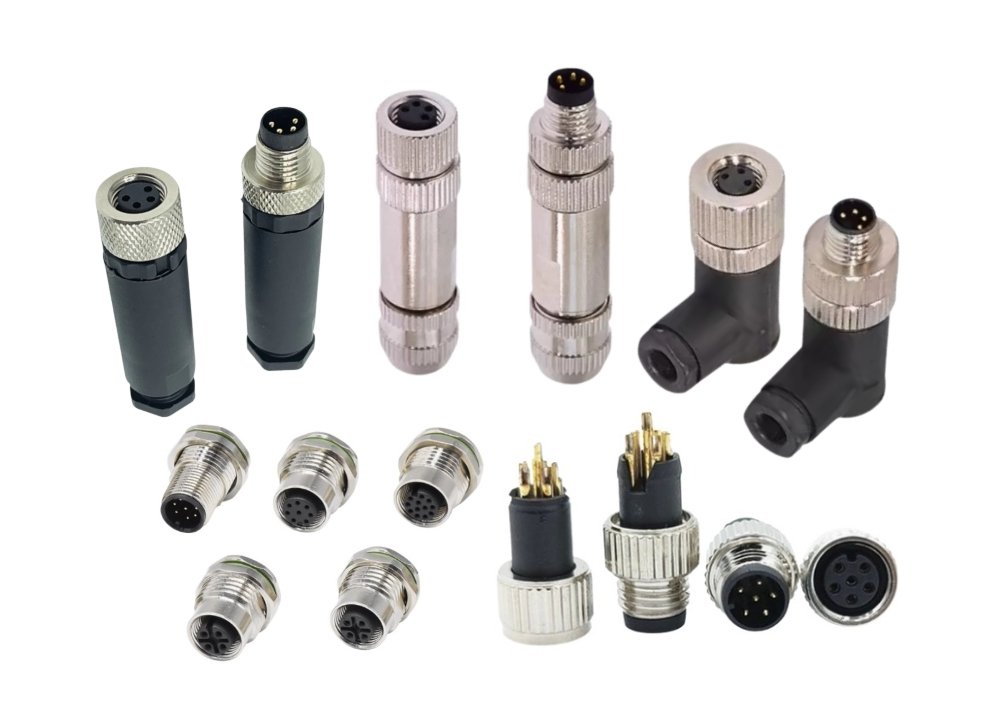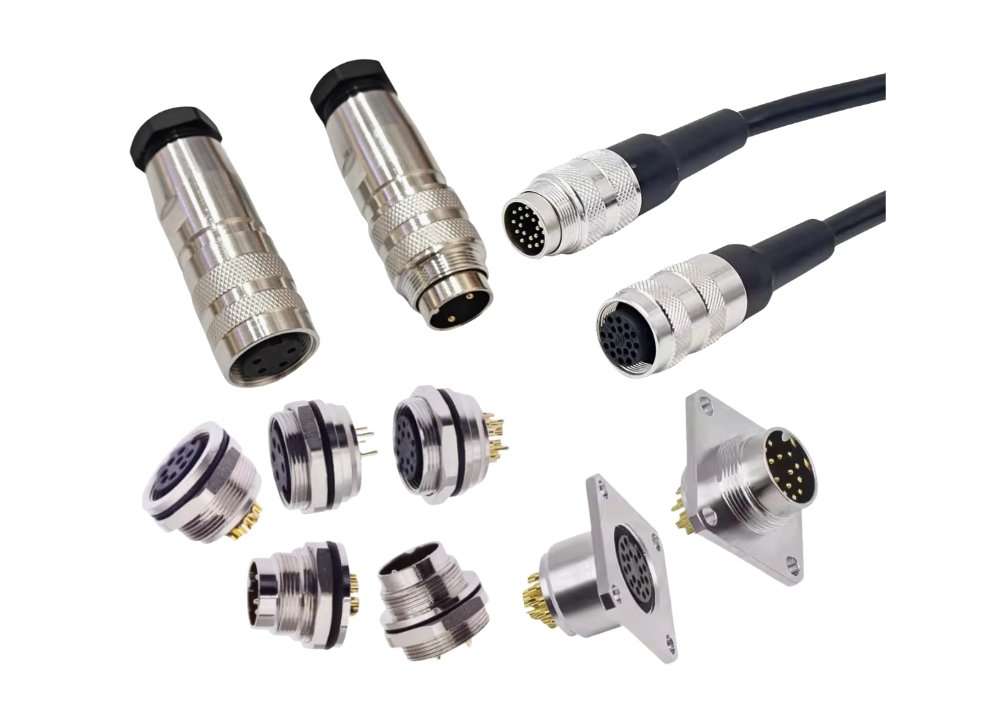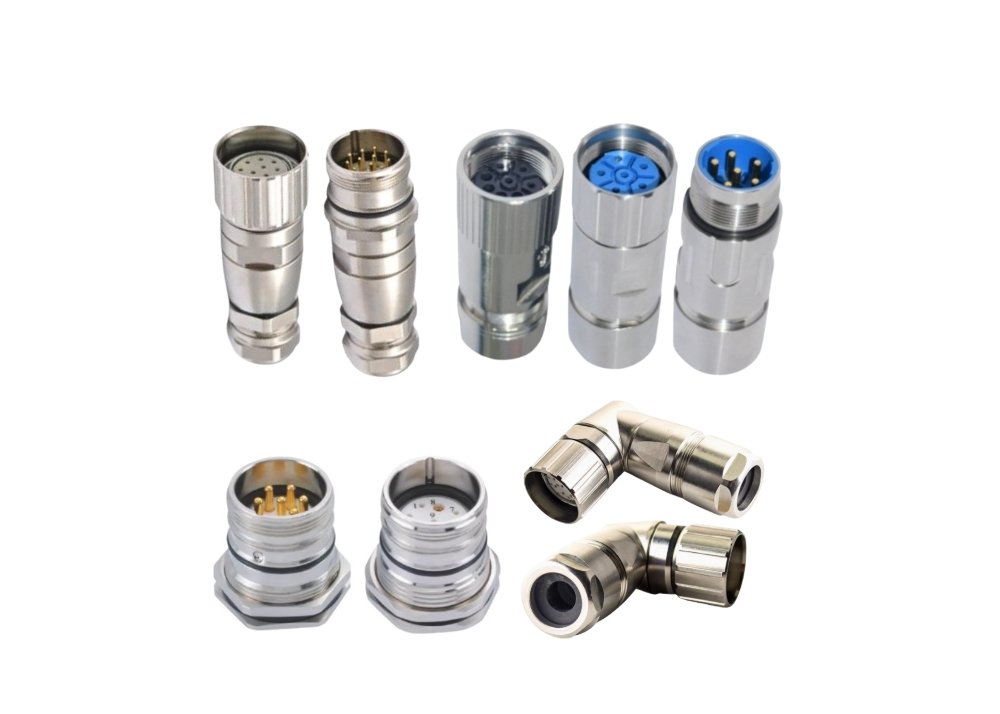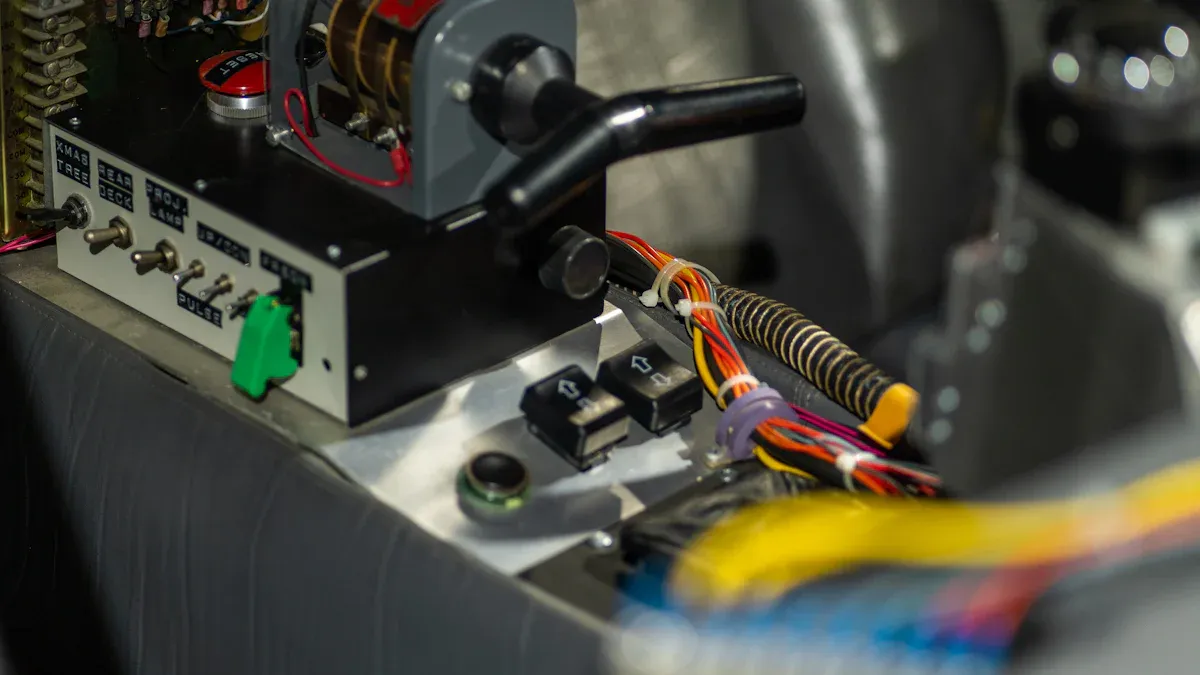
You face increasing demands for robust industrial connectors as the M12 system market surges, driven by smart manufacturing and automation.
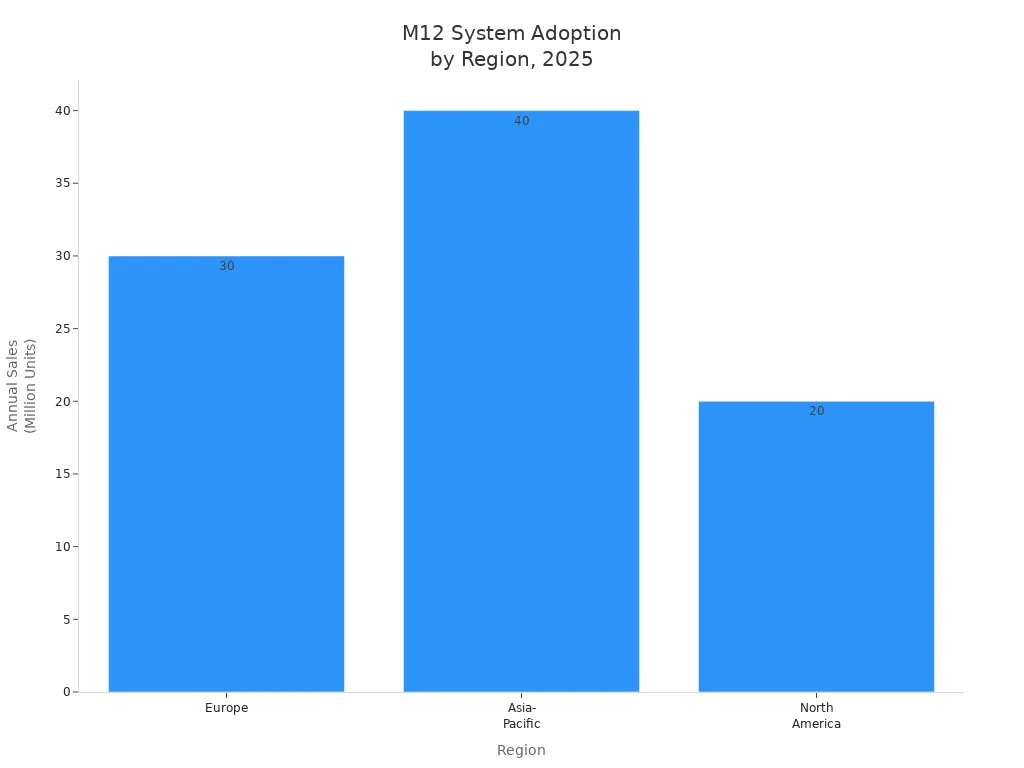
When integrating 490/12 connectors with 100-12 M12 systems, you must verify compatibility, safety, and performance. Select the right M8 connector or Type B connector from a trusted connector factory. These steps help you achieve reliable connections in demanding industrial environments.

Industrial Connectors and the 2025 M12 System Landscape

Evolving Standards and Industry Trends
Industry 4.0 and Smart Manufacturing
You operate in a world where Industry 4.0 drives rapid change. Smart manufacturing relies on real-time data, automation, and interconnected systems. Industrial connectors play a vital role in linking sensors, actuators, and controllers. You see new trends shaping the market:
- U.S. tariffs on imports increase production costs and disrupt supply chains, pushing companies to seek alternative sources or domestic manufacturing.
- Growth in emerging markets like India, China, and Brazil fuels demand for advanced connectors.
- Miniaturization and ruggedness become essential as you require smaller, lighter connectors that withstand harsh conditions.
- Sustainability gains importance, with manufacturers developing eco-friendly connectors to save energy and reduce waste.
- Smart and hybrid connectors, such as those with embedded sensors and IP67 sealing, support multifunctionality and intelligent manufacturing.
- Automation and robotics increase the need for reliable, high-performance connectors.
Modular Connectivity Demands
You must adapt to modular connectivity demands. Modern factories require flexible, reconfigurable systems. Industrial connectors now offer modular designs, allowing you to expand or reconfigure your setup quickly. This flexibility supports smart factories and Industry 4.0 initiatives, where you need to connect and disconnect devices without downtime.
Importance of M12 Systems in Industrial Connectors
Reliability in Harsh Environments
You depend on M12 systems for their proven reliability. These connectors withstand mechanical stress, shock, vibration, and extreme temperatures. High IP ratings, such as IP67 and IP69K, protect against dust and water. Shielding prevents electromagnetic and radio frequency interference, ensuring signal integrity. Secure locking mechanisms and high mating cycle durability reduce the risk of accidental disconnections.
Versatility Across Industrial Applications
M12 connectors adapt to a wide range of uses. You find them in automation, robotics, transportation, and process industries. Their standardized codings and pin-outs simplify integration with Ethernet, USB, Serial, and CAN interfaces. You benefit from easy assembly and maintenance, even in challenging environments.
Compatibility and Future-Proofing with Industrial Connectors
Interoperability with Emerging Technologies
You face new compatibility challenges as technology advances. Connectors must support higher data rates, increased power handling, and integration with 5G and autonomous systems. You require solutions that maintain performance in extreme environments and meet cybersecurity requirements for secure data transmission.
| Compatibility Challenge | Description |
|---|---|
| High Initial Cost | Advanced materials and designs raise manufacturing costs. |
| Fragmented Regulatory Landscape | Evolving standards complicate compliance and increase development time. |
| Modularity and Reconfigurability | Flexible, modular connectors add design complexity. |
| Cybersecurity Considerations | Secure connections protect data integrity in interconnected networks. |
Compliance with 2025 Standards
You benefit from unified standards, such as the IEC 61076-2-101 for M12 connectors. This standard ensures compatibility across manufacturers and simplifies installation. Recent innovations, like patented torque sleeves and new plug body styles, make installation faster and more secure. These advancements reflect the trend toward ruggedness, ease of use, and future-proofing in industrial connectors.
490/12 Industrial Connectors: Features and Integration Benefits
Technical Specifications of 490/12 Connectors
Electrical and Mechanical Ratings
You need to understand the electrical and mechanical ratings before selecting 490/12 connectors for your M12 system. These ratings determine how well the connector will perform in your application. The following table summarizes the key specifications:
| Parameter | Specification |
|---|---|
| Rated voltage | 60 V |
| Rated impulse voltage | 800 V |
| Rated current | 2.0 A |
| Insulation resistance | ≥ 10¹⁰ Ω |
| Pollution degree | 2 |
| Overvoltage category | II |
| Mechanical operation cycles | > 500 mating cycles |
| Temperature range | -40 °C to 85 °C |
| Degree of protection | IP67 |
| Connection cross-section | max. 0.25 mm² / AWG 24 |
You can rely on these connectors to deliver stable performance in demanding environments. The high insulation resistance and robust voltage ratings help you maintain safety and prevent electrical faults. With more than 500 mating cycles, you get long-term durability for frequent connections and disconnections.
Environmental Protection (IP Ratings)
You often work in environments where dust, moisture, and vibration threaten your equipment. The 490/12 connectors offer IP67 protection, which means you can submerge them in water up to one meter for 30 minutes without damage. This level of protection ensures your connections remain secure, even in harsh industrial settings. You reduce downtime and maintenance costs by choosing connectors with high IP ratings.
Design and Construction of Industrial Connectors
Materials and Durability
You want connectors that last. Manufacturers use high-grade materials like nickel-plated brass or stainless steel for the housing. These materials resist corrosion and mechanical wear. The contact pins often use gold or silver plating, which improves conductivity and reduces signal loss. You benefit from connectors that withstand repeated use and exposure to chemicals or extreme temperatures.
Tip: Choose connectors with reinforced locking mechanisms. You will prevent accidental disconnections and improve system reliability.
Pin Configurations and Coding Types
You need flexibility when integrating connectors into your system. The 490/12 series supports multiple pin configurations, such as 3, 4, 5, or 8 pins. This variety allows you to match the connector to your specific signal or power requirements. Coding types, like A, B, D, or X, help you prevent mismating and ensure proper connections. You simplify installation and reduce errors by selecting the right coding for your application.
Advantages for M12 System Integration
Ease of Installation
You save time during installation with 490/12 connectors. The design supports quick and secure assembly, often without special tools. Pre-assembled cable options further reduce setup time. You can connect and disconnect devices rapidly, which is essential for modular and flexible production lines.
Signal Integrity and Reliability
You rely on consistent signal transmission for your automation systems. The 490/12 connectors use shielded designs and high-quality contacts to minimize electromagnetic interference. This feature ensures data and power signals remain stable, even in noisy industrial environments. You maintain system uptime and reduce troubleshooting efforts by using connectors that protect signal integrity.
Note: Reliable industrial connectors form the backbone of your M12 system. You ensure long-term performance and safety by choosing connectors with proven design and robust specifications.
Step-by-Step Guide: Using 490/12 Industrial Connectors with 100-12 M12 System Integration
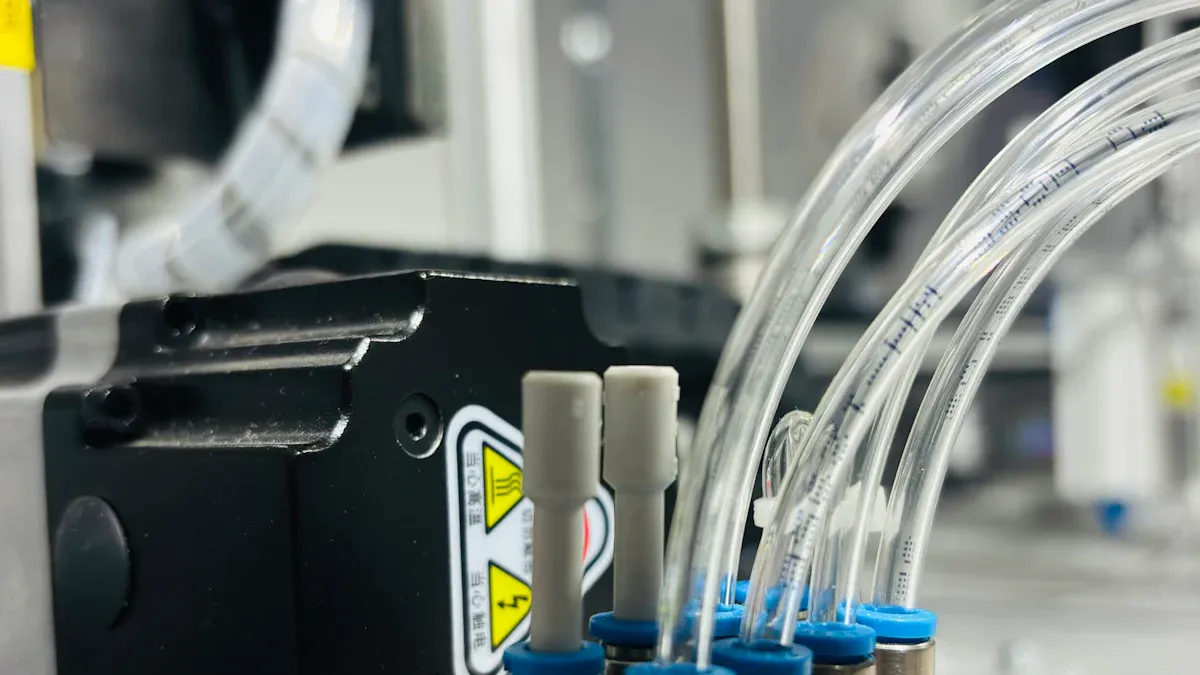
Preparation and Planning for Integration
Assessing System Requirements
You start by evaluating your system’s operational needs. Identify the voltage, current, and signal types required for your application. Review the environmental conditions, such as exposure to moisture, dust, vibration, and temperature extremes. Determine the number of connections and the type of data transmission your process demands. You should also consider future scalability and modularity, ensuring your setup can adapt to new technologies or increased capacity.
Tip: Document all technical specifications and environmental factors before selecting components. This step helps you avoid compatibility issues and ensures reliable performance.
Selecting Compatible Industrial Connectors
You select connectors that match your system’s requirements. Check the rated voltage, current, and IP protection level of each connector. Confirm that the pin configuration and coding type align with your devices. Choose connectors from reputable manufacturers who comply with international standards, such as IEC 61076-2-101. Verify that the connectors support the mechanical and electrical demands of your application.
Checklist for Selecting Connectors:
- Match voltage and current ratings to system needs.
- Confirm pin configuration and coding type.
- Ensure IP rating meets environmental requirements.
- Select connectors from trusted manufacturers.
- Verify compliance with relevant standards.
Connection and Assembly Process
Cable Preparation and Termination
You prepare cables with precision. Cut cables to the required length and strip insulation according to manufacturer guidelines. Clean wire ends to remove debris or oxidation. Use the correct crimping or soldering tools for terminal attachment. Avoid excessive force during wire preparation, as improper stripping length or inadequate cleaning can lead to poor connections and signal loss.
Common Cable Preparation Mistakes:
- Incorrect stripping length.
- Inadequate cleaning of wire ends.
- Using improper crimping or soldering tools.
- Ignoring polarity or orientation.
Alert: Always follow manufacturer instructions for cable preparation. Improper handling can cause wire damage, incomplete terminal seating, and connector failures.
Connector Assembly and Mating Procedures
You assemble connectors with care. Align connector halves properly before mating. Insert connectors gently, avoiding excessive force that can bend or break pins. Tighten locking mechanisms to the recommended torque, preventing loose or over-tightened connections. Inspect each assembly visually to confirm correct seating and orientation.
Assembly Best Practices:
- Align connectors before insertion.
- Apply gentle, even pressure.
- Use recommended torque for locking.
- Perform visual inspection after assembly.
You minimize risks by maintaining an organized workspace and using proper tools. Mishandling harnesses or using connectors with sharp edges can cause wire snags or latch breakage. Repetitive strain injuries and poor workspace layout also affect assembly quality.
Verification and Testing Procedures
Continuity and Signal Testing
You verify each connection with continuity and signal tests. Use a multimeter to check for electrical continuity across all pins. Confirm that signal transmission meets system specifications. Test for stable data flow and absence of interference. Address any issues immediately to prevent system failures.
| Test Type | Purpose | Recommended Tool |
|---|---|---|
| Continuity Test | Check electrical connection | Multimeter |
| Signal Integrity | Verify data transmission | Oscilloscope |
| Polarity Check | Confirm correct orientation | Multimeter |
Note: Regular testing ensures reliable operation and helps you detect faults early.
Environmental and Mechanical Checks
You conduct environmental and mechanical checks to confirm long-term reliability. Inspect connectors for proper sealing and IP rating compliance. Test assemblies under simulated environmental conditions, such as vibration, moisture, and temperature extremes. Check for mechanical stability by gently tugging on cables and connectors. Look for signs of wear, corrosion, or damage.
Environmental and Mechanical Inspection Steps:
- Verify IP rating and sealing.
- Simulate vibration and moisture exposure.
- Inspect for corrosion or physical damage.
- Confirm mechanical stability of connections.
You prevent failures by following these steps and adhering to manufacturer guidelines. Avoid using connectors from different standards or regions, as this can risk warranty voids and system incompatibility.
Best Practices for Industrial Connectors in M12 System Integration
Installation Tips for Industrial Connectors
Proper Torque and Tightening
You ensure reliable connections by applying the correct torque during installation. Industry experts recommend tightening locking nuts to 1 Nm for M12 connectors. This practice maintains sealing and connection integrity. Over-tightening can damage threads or seals, while under-tightening may cause loose connections and water ingress. Always use a calibrated torque wrench and follow manufacturer guidelines.
| Aspect | Key Recommendations and Practices |
|---|---|
| Crimp Connectors | Use matched crimping tools; insert stripped wires fully; apply firm pressure; inspect crimps; test by gentle pull. |
| Push-in Connectors | Strip wires to recommended length; insert fully until click; ensure no exposed copper; verify security by pulling. |
| Insulation Displacement | Insert unstripped wire; use punch-down tool; confirm tight connection. |
| Safety | Always de-energize circuits before work; use insulated tools and PPE; follow OSHA and NFPA 70E standards. |
| Common Mistakes | Incorrect wire stripping length; wrong connector size; over/under-tightening; inadequate inspection. |
Tip: Always perform a gentle pull test after tightening to confirm secure connections.
Cable Management Strategies
You organize cables to prevent strain and damage. Use cable jackets, protective covers, and strain relief features to reduce mechanical stress. Avoid sharp bends and excessive tension. Route cables away from sources of vibration and heat. Maintain a clean workspace free from dust and debris. Document cable routing and connector locations for future maintenance.
Maintenance and Inspection of Industrial Connectors
Routine Checks and Cleaning
You prolong connector lifespan by conducting regular inspections. Check for loose connections, corrosion, and signs of overheating daily. Clean connectors using contact cleaners or isopropyl alcohol. Tighten electrical terminals periodically. Integrate these tasks into daily, weekly, and monthly schedules based on equipment criticality.
- Inspect connectors and cables for defects before installation.
- Clean wires and remove insulation carefully.
- Use corrosion-resistant materials and gel-filled connectors to prevent moisture ingress.
- Employ advanced diagnostic tools like thermal imaging to identify hidden faults.
Identifying Wear and Damage
You detect wear and damage through visual inspections. Look for discoloration, cracks, or physical deformation. Monitor for signs of corrosion or moisture ingress, especially after severe weather events. Replace damaged or aging connectors promptly. Use strain relief features to reduce mechanical stress and prolong durability.
Troubleshooting Common Issues with Industrial Connectors
Connection Failures
You encounter connection failures due to loose or unstable connections and intermittent signal transmission. Causes include poor contact, insufficiently tightened locking nuts, and damaged cable connections. Inspect and replace damaged O-rings and seals to prevent water ingress. Verify correct connector coding and pin configuration before installation.
- Loose or disconnected connectors cause communication or power loss.
- Bent or corroded pins lead to poor contact.
- Connections restored by wiggling suggest broken locking mechanisms.
Signal Loss or Interference
You address signal loss by checking for intermittent power or data transmission. Common causes include vibration, pin misalignment, and improper mating. Shielding failures and electromagnetic interference also disrupt communication. Test continuity with a multimeter to detect broken wires. Replace connectors to isolate network-related issues.
Note: Regular cleaning and inspection help avoid oxidation and contamination, ensuring stable performance of industrial connectors.
Application Scenarios: Industrial Connectors in Real-World M12 System Integration
Factory Automation and Robotics
Motion Control Systems
You rely on precise motion control systems to automate tasks in modern factories. Industrial connectors play a critical role in linking motors, drives, and controllers. You need connectors that withstand vibration and repeated movement. M12 connectors offer secure locking and high mating cycles, which help you maintain consistent performance. You can quickly replace faulty components, reducing downtime and keeping your production line running smoothly.
Sensor Networks
You deploy sensor networks to monitor temperature, pressure, and position in real time. Industrial connectors ensure reliable data transmission between sensors and control units. You benefit from shielded designs that protect against electromagnetic interference. Modular connector options allow you to expand your network as your needs grow. You achieve fast installation and easy maintenance, which supports flexible manufacturing.
Transportation and Logistics Applications
Automated Guided Vehicles (AGVs)
You use AGVs to move materials efficiently in warehouses and distribution centers. Industrial connectors provide robust connections for power and data signals. You need connectors that resist dust, moisture, and vibration. M12 connectors with high IP ratings keep your AGVs operational in challenging environments. You can swap out connectors quickly, minimizing interruptions to your logistics flow.
Conveyor and Sorting Systems
You depend on conveyor and sorting systems to handle packages and products. Industrial connectors link sensors, actuators, and control panels along the conveyor path. You require connectors that support frequent plugging and unplugging. M12 connectors offer reliable locking and easy assembly. You maintain high throughput and reduce maintenance time by choosing connectors designed for industrial use.
Process Industry Use Cases
Food and Beverage Production
You face strict hygiene and safety standards in food and beverage production. Industrial connectors must use materials that resist bacterial growth, corrosion, and chemical leaching. You select connectors made from high-alloy stainless steel or approved plastics. You look for designs with smooth, sealed surfaces that allow easy cleaning and sterilization. Modular connectors help you perform maintenance quickly, reducing downtime.
- Materials must comply with EN 1672-2, NSF/ANSI, and FDA 21 CFR regulations.
- Connectors should avoid cavities that trap contaminants.
- IP69K protection ensures connectors withstand high-pressure washdowns.
- Vulcanized rubber with silicone enhances temperature and abrasion resistance.
Tip: Choose connectors with ergonomic features and advanced sealing to meet food zone requirements.
Chemical and Pharmaceutical Processing
You operate in environments with aggressive chemicals and strict safety rules. Industrial connectors must resist corrosion and prevent chemical leaching. You select connectors with specialized materials, such as vulcanized rubber and silicone, for superior durability. You require designs that meet UL, CSA, and IEC standards for electrical safety and extreme sealing. Modular connector systems simplify maintenance and support fast upgrades.
- Smooth surfaces and sealed housings prevent contamination.
- Compression nuts and cable glove seals improve reliability.
- Five-year real-life testing ensures connectors withstand harsh conditions.
You maintain compliance and protect your process integrity by choosing connectors designed for chemical and pharmaceutical applications.
Key Considerations for Industrial Connectors in 2025 and Beyond
Scalability and Upgradability of M12 Systems
Modular Expansion Options
You need your M12 systems to grow with your business. Modular expansion options let you add or replace components without major downtime. You can use plug-and-play modules to scale up production lines or adapt to new automation needs. This flexibility supports rapid changes in manufacturing and helps you stay competitive. When you choose modular industrial connectors, you simplify upgrades and reduce installation time. You also lower costs by reusing existing infrastructure.
Integration with IoT Platforms
You see the industrial Internet of Things (IoT) transforming how factories operate. M12 systems now connect sensors, actuators, and controllers to cloud-based platforms. You gain real-time data for predictive maintenance and process optimization. To achieve this, you need connectors that support high-speed data transfer and secure communication. Industrial connectors with advanced shielding and coding types help you avoid signal loss and interference. You ensure your systems remain future-ready by selecting connectors designed for IoT integration.
Regulatory and Safety Compliance for Industrial Connectors
Meeting International Standards
You must comply with strict international standards to ensure safety and market acceptance. In 2025, medical connectors must meet ISO 80369 to prevent misconnections and improve patient safety. Regulatory authorities like the FDA and EMA require you to follow these standards for quality and interoperability. Non-compliance can lead to product recalls or legal issues, so you must stay updated on the latest requirements.
Across industries, you also face region-specific updates. For example, South Korea updated its EMC standard KS C 9832 and proposed a USB Type-C mandate for portable devices. Taiwan revised safety standards for household electrical products. These changes mean you must verify that your connectors meet local and global regulations before installation.
| Region | Regulatory/Safety Update | Key Compliance Requirements | Effective Date | Notes |
|---|---|---|---|---|
| South Korea | KS C 9832 EMC update | Revised EMC testing for multimedia equipment | Jan 3, 2025 | Aligns with global EMC practices |
| South Korea | USB Type-C mandate (draft) | USB Type-C for portable devices | Feb 14, 2025 (phase 1) | Pending National Assembly approval |
| South Korea | KATS market surveillance | Increased inspections for KC compliance | Ongoing 2025 | Non-compliant products risk removal |
| Taiwan | RPC safety standards update | New CNS standards for electrical products | April 24, 2025 | Existing certifications valid until expiration |
You also need certifications like FDA, USDA, and ATEX for food, agriculture, and hazardous environments. These certifications confirm that your connectors meet hygiene, safety, and explosion protection standards.
Documentation and Certification Requirements
You must provide thorough documentation for every installation. In hazardous environments, you need certifications such as ATEX, Ex, and IECEx. These prove your connectors prevent ignition risks and meet safety standards. You should include certification codes, technical specifications, and testing records in your documentation.
For industrial control panels, UL 508A certification is essential in North America. You must prepare drawings, schematics, component lists, and testing records. Proper labeling with manufacturer and compliance information helps inspection authorities approve your equipment. Enclosures must meet UL 50 ratings to ensure environmental protection.
You also need to comply with NFPA 70 NEC Article 110.3, which requires UL certifications for wire connectors and terminals. UL provides CB Certificates for international compliance. By maintaining complete documentation and up-to-date certifications, you ensure your industrial connectors are safe, reliable, and accepted in every market.
Quick-Reference Checklist for Industrial Connector Integration Success
Pre-Installation Checklist
Before you begin integrating 490/12 connectors with M12 systems, you should follow a structured pre-installation checklist. This approach helps you avoid costly mistakes and ensures a smooth installation process.
- Confirm that the connector coding matches your application to guarantee compatibility.
- Verify the pin configuration aligns with your device requirements to prevent wiring errors.
- Inspect each connector for visible damage or contamination that could affect connection quality.
- Check that the IP rating meets the environmental conditions where you will use the connectors.
- Select cables with proper shielding and temperature resistance for your application environment.
- Prepare all necessary tools, such as torque wrenches, to ensure secure assembly.
- Review datasheet specifications for voltage and current ratings to confirm they meet your needs.
- Clean all mating surfaces thoroughly to prevent dust or debris from impacting the electrical connection.
- Plan your installation layout to allow easy access for future maintenance and troubleshooting.
🛠️ Tip: Careful preparation reduces installation errors and extends the lifespan of your connectors.
Post-Installation Verification Steps
After installation, you need to verify that your system operates as intended. A thorough post-installation check ensures reliability and security.
- Test connectivity by confirming that required network ports, such as 443 and 80, are open using tools like telnet.
- Ensure firewall and backend proxy settings allow access to necessary domains and ports.
- Test sign-in capability by accessing secure login portals, such as https://login.microsoftonline.com.
- Validate that your connector machine and backend components support current security protocols, including TLS 1.2 and SHA512 certificates.
- Check the client certificate’s thumbprint and storage location, confirming it is in the correct store.
- Renew expired client certificates by re-registering the connector or reinstalling as needed.
- Confirm that the installer has administrator privileges, especially the Application Administrator role in Microsoft Entra ID.
- Troubleshoot any connector errors by reviewing event logs or using PowerShell commands to resolve registration issues.
🔍 Note: Always log out of administrative sessions and reset passwords regularly to maintain system security.
Ongoing Maintenance Reminders
To ensure long-term performance, you must prioritize regular maintenance and monitoring.
- Schedule regular inspections and maintenance based on time, usage, or condition to prevent unexpected failures.
- Use predictive maintenance tools, such as IoT sensors and condition monitoring, to detect early signs of wear.
- Focus your resources on critical assets whose failure could disrupt operations.
- Update preventive maintenance schedules frequently to keep your activities relevant and effective.
- Use maintenance software to centralize tracking and automate reminders for all maintenance tasks.
- Track key metrics, such as downtime and failure rates, to evaluate and improve your maintenance strategy.
- Conduct root cause analysis for any failures to prevent recurrence and boost reliability.
⏰ Reminder: Preventive maintenance reduces downtime, extends equipment life, and improves safety for your entire operation.
You achieve successful integration by following clear steps for connecting 490/12 connectors with 100-12 M12 systems. You gain faster decision-making, cost savings, and streamlined compliance when you design modular systems and ensure scalability. You future-proof your projects by vetting third-party components, building interoperability, and investing in ongoing training.
- Always check compatibility and security features.
- Use APIs and cloud integration for flexibility.
- Monitor systems and adapt quickly to new technologies.
Stay informed about evolving standards to maximize the value of your industrial connectors.
FAQ
What makes M12 connectors suitable for harsh industrial environments?
You benefit from M12 connectors because they offer high IP ratings, robust locking mechanisms, and corrosion-resistant materials. These features protect your connections from dust, water, and vibration, ensuring reliable performance in demanding settings.
How do you select the right coding type for your application?
You match the coding type to your signal or power requirements. For example, use A-coding for sensors, B-coding for Profibus, D-coding for Ethernet, and X-coding for high-speed data. This prevents mismating and ensures proper function.
Can you mix connectors from different manufacturers?
You can mix connectors if they comply with the same standards, such as IEC 61076-2-101. Always verify pin configuration, coding, and IP rating. Incompatible connectors may cause failures or void warranties.
What routine maintenance should you perform on industrial connectors?
You should inspect connectors for wear, corrosion, and loose contacts. Clean them with approved solutions. Tighten locking mechanisms as needed. Schedule regular checks to prevent unexpected failures and extend connector lifespan.
How do you troubleshoot signal loss in M12 connector systems?
You start by checking for loose connections, bent pins, or damaged cables. Use a multimeter to test continuity. Replace faulty components. Shielded connectors help reduce electromagnetic interference.
What standards must you follow for industrial connector compliance in 2025?
You must follow IEC 61076-2-101 for M12 connectors. For hazardous areas, use ATEX or IECEx certified products. Regional standards, such as UL 508A or KS C 9832, may also apply. Always review documentation before installation.
Are M12 connectors ready for Industry 4.0 and IoT integration?
You can use M12 connectors for Industry 4.0 and IoT because they support high-speed data, modular expansion, and secure connections. Choose connectors with advanced shielding and coding to ensure reliable integration with smart systems.
What are the most common mistakes during connector installation?
You may strip wires incorrectly, use the wrong torque, or mismatch coding types. These errors can cause poor connections or system failures. Always follow manufacturer guidelines and use the correct tools.

